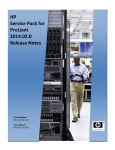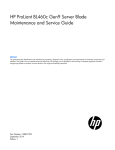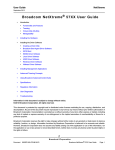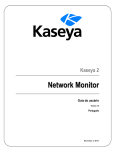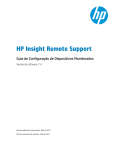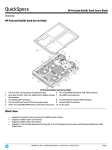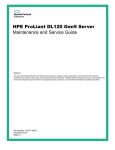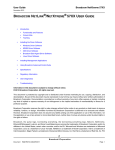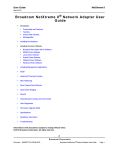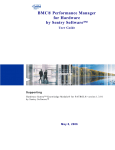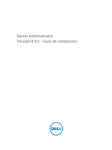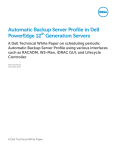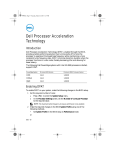Download HP CN1000E User's Manual
Transcript
Broadcom BACS for HP FlexFabric and
StoreFabric Adapters
User Guide
Abstract
This document is for the person who installs, administers, and troubleshoots servers and storage systems. HP assumes you are qualified in the
servicing of computer equipment and trained in recognizing hazards in products with hazardous energy levels.
Part Number: 741900-003
April 2014
Edition: 3
© Copyright 2013, 2014 Hewlett-Packard Development Company, Development Company, L.P.
The information contained herein is subject to change without notice. The only warranties for HP products and services are set forth in the express
warranty statements accompanying such products and services. Nothing herein should be construed as constituting an additional warranty. HP shall
not be liable for technical or editorial errors or omissions contained herein.
AMD is a trademark of Advanced Micro Devices, Inc. Intel is a trademark of Intel Corporation in the U.S. and other countries.
Microsoft®, Windows®, and Windows Server® are U.S. registered trademarks of Microsoft Corporation.
Contents
Introduction .................................................................................................................................. 5
BACS overview ............................................................................................................................................ 5
Starting BACS .............................................................................................................................................. 5
BACS interface on Microsoft Windows operating systems ................................................................................ 5
Explorer View pane ............................................................................................................................ 5
Context View selector ......................................................................................................................... 6
Context View pane ............................................................................................................................. 6
Menu bar .......................................................................................................................................... 6
Description pane ................................................................................................................................ 7
Installation overview ...................................................................................................................... 8
Introduction ................................................................................................................................................. 8
Hardware requirements ................................................................................................................................ 8
Software requirements .................................................................................................................................. 8
Communication protocols .............................................................................................................................. 9
Installation summary ..................................................................................................................................... 9
Installation summary for Microsoft Windows operating systems ............................................................... 9
Installation summary for Linux operating systems.................................................................................. 10
Installing BACS components on Microsoft and Linux operating systems ............................................. 12
WinRM installation steps ............................................................................................................................. 12
Basic configuration ........................................................................................................................... 12
User configuration ............................................................................................................................ 12
Configuring HTTP ............................................................................................................................. 12
Configuring HTTPS ........................................................................................................................... 13
Generating a self-signed certificate for Microsoft and Linux servers ........................................................ 14
Installing the management application .......................................................................................... 18
Installation on Microsoft Windows OS ......................................................................................................... 18
Installing the BACS management client on a Microsoft Windows operating system ................................. 18
Configuring HTTP on Microsoft operating systems ................................................................................ 18
Configuring HTTPS on Microsoft operating systems .............................................................................. 19
Testing a client WinRM HTTPS/SSL connection.................................................................................... 19
Installation on Linux OS .............................................................................................................................. 19
Downloading and unpacking HP SoftPaq ........................................................................................... 20
Installing OpenSSL and OpenPegasus ................................................................................................ 20
Installing WS-MAN and CimXML on Linux OS .................................................................................... 21
Installing OpenPegasus from Inbox RPM for Red Hat............................................................................ 21
Installing OpenPegasus from Source for Red Hat and SuSE .................................................................. 21
Launching the application ............................................................................................................ 29
Launching the GUI in Microsoft Windows OS ............................................................................................... 29
Launching the GUI in Linux OS .................................................................................................................... 29
Closing the GUI in Microsoft Windows OS ................................................................................................... 29
Launching the CLI from Microsoft Windows OS ............................................................................................. 29
Launching the CLI from Linux OS .................................................................................................................. 29
Closing the CLI........................................................................................................................................... 29
Contents
3
Configuration ............................................................................................................................. 30
Configuring preferences.............................................................................................................................. 30
Enabling or disabling the BACS tray icon ........................................................................................... 30
Setting Explorer View refresh time ...................................................................................................... 30
Connecting to a host .................................................................................................................................. 30
Adding a local host .......................................................................................................................... 30
Adding a remote host ....................................................................................................................... 30
Managing the host ..................................................................................................................................... 31
Information tab ................................................................................................................................ 31
Configuration tab ............................................................................................................................. 31
Managing the network adaptor ................................................................................................................... 31
Viewing adapter information ............................................................................................................. 32
Viewing resource information ............................................................................................................ 32
Viewing hardware information .......................................................................................................... 32
Configuring adapter parameters ........................................................................................................ 33
Configuring multi-function parameters................................................................................................. 33
Hardware and resource configuration wizard ..................................................................................... 33
Managing the Ethernet controller (port) ......................................................................................................... 33
Viewing port level information ........................................................................................................... 33
Viewing vital signs ........................................................................................................................... 34
Managing the LAN device .......................................................................................................................... 35
Viewing NDIS information................................................................................................................. 35
Viewing resource information ...................................................................................................................... 36
Viewing statistics .............................................................................................................................. 36
Viewing resource reservations ........................................................................................................... 39
Changing the MTU size of iSCSI ports ................................................................................................ 39
Configuring the IP address for iSCSI offload ....................................................................................... 39
CLI commands ............................................................................................................................ 41
Configuring with the CLI utility ..................................................................................................................... 41
Support and other resources ........................................................................................................ 42
Before you contact HP ................................................................................................................................ 42
HP contact information ................................................................................................................................ 42
Acronyms and abbreviations ........................................................................................................ 43
Documentation feedback ............................................................................................................. 46
Index ......................................................................................................................................... 47
Contents
4
Introduction
BACS overview
BACS is an integrated utility that provides useful information about each network adapter installed in a
system. BACS provides views of property values and traffic statistics for network objects. BACS also enables
modification of property values. BASP functionality configures VLANs and runs within BACS systems that use
at least one Broadcom-based network adapter.
Starting BACS
From the Control Panel, click Broadcom Control Suite 4 to start the BACS. Or, click the BACS icon located in
the taskbar at the bottom of the Windows desktop.
BACS interface on Microsoft Windows operating
systems
The BACS Microsoft Windows interface contains the following regions:
•
Explorer View pane
•
Context View selector
•
Context View pane
•
Menu bar
•
Description pane
The default configuration docks and pins the Explorer View pane on the left side of the main window, the
Context View pane on the right, the Context View selector below the menu bar, and the Description pane
below the Context View pane. Drag the splitter between any two panes to vary the pane size.
Explorer View pane
Dock and pin the Explorer View pane on the left side, right side, top, or bottom of the main window.
The Explorer View pane lists the objects that you can view, analyze, test, or configure using BACS. When
you select an item from the Explorer View pane, the Context View pane displays the tabs with the information
and options available for the item.
The organization and design of this panel presents the manageable objects in the same hierarchical manner
as drivers and subcomponents. This simplifies the management of various elements of the adapters. The top
level of the hierarchy is the Host container, which lists all hosts managed by BACS. Below the hosts are the
installed network adapters, with the manageable elements such as physical port VBD, NDIS, FCoE, and
iSCSI, below the adapters.
Introduction
5
The icon next to each device in the Explorer View pane shows its status. An icon next to a device name that
appears normal means the device is connected and working.
•
X appears on the device icon to indicate the device is currently not connected to the network.
•
Greyed out device icons indicate the device is currently disabled.
Context View selector
The Context View selector appears below the menu bar and includes the filter and tab categories. Expand or
collapse the categories that appear on the tabs in the Context View pane. To display a category, select the
box next to the category name.
Filter view
A multiple-host environment that uses different adapters and contains multiple configurable elements can be
difficult to manage. Use the following view filters to increase device administration efficiency:
•
All
•
NDIS/L2NIC
•
iSCSI
•
FCoE
•
iSCSI target
•
FCoE target
Context View pane
The Context View pane displays all the parameters that you can view for the object selected in the Explorer
View pane. The parameters are grouped by tabs and categories, depending on the parameter type. The
available tabs are Information, Configuration, Diagnostics, and Statistics. Because the BACS interface is
context-sensitive, only the parameters that apply to the selected object can be viewed or configured in the
Context View pane.
Menu bar
The following options appear on the menu bar. Because the menu items are context-sensitive, not all items are
available at all times.
File menu
Action menu
•
Add Host adds the selected host.
•
Discover Hosts discovers hosts.
•
Boot Configurations configures the iSCSI boot parameters.
•
Remove Hosts removes the selected host.
•
Remove All Hosts removes all the hosts.
•
Refresh All refreshes all the hosts.
View menu
Introduction
6
•
Explorer View displays and hides the Explorer View pane.
•
Tool Bar displays and hides the tool bar.
•
Status Bar displays and hides the status bar.
•
Broadcom Logo displays and hides the logo on BACS to optimize the maximum viewable space.
Tools menu
Options configure BACS preferences.
iSCSI menu
•
Discovery Wizard locates targets and helps to configure the HBA.
•
Manage Targets Wizard manages targets.
•
Manage iSNS Servers manages iSNS servers to allow discovery, management, and configuration of
iSCSI devices.
•
Manage Discovery Portals manages iSCSI discovery portals.
Discovery Wizard
The Discovery Wizard is available from the iSCSI menu. Follow the prompts in the wizard to discover iSCSI
targets using the SendTargets method or the Internet iSNS server.
Manage iSNS Servers
The Manage iSNS Servers window is available from the iSCSI menu. Add or remove iSNS servers from this
window.
Manage Discovery Portals
The Manage Discovery Portals window is available from the iSCSI menu. Add or remove iSCSI discovery
portals from this window.
Boot Configuration Wizard
The Boot Configuration Wizard is available by right-clicking a port. Follow the prompts in the wizard to
configure the iSCSI boot parameters.
Hardware and Resource Configuration Wizard
Use the Hardware and Resource Configuration Wizard to configure properties for hardware resources.
Follow the prompts in the wizard to configure hardware resources. You can preview the configuration before
committing the changes.
Description pane
The Description pane provides information, configuration instructions, and options for the selected
parameter in the Context View pane.
Introduction
7
Installation overview
Introduction
BACS management can be installed on both Microsoft Windows and Linux platforms.
The BACS installer package for the Microsoft Windows OS is based on Microsoft MSI installation
technology. The Broadcom Windows CIM provides WS-MAN and WMI protocol support for client-server
connections.
The Broadcom Linux CIM provides WS-MAN protocol and CimXML protocol support for client-server
connections.
Hardware requirements
Systems that host BACS must meet the following hardware requirements:
•
At least one of the following HP FlexFabric adapters:
o
HP FlexFabric 10Gb 2-port 534M Adapter
o
HP FlexFabric 10Gb 2-port 534FLR-SFP+ Adapter
o
HP FlexFabric 10Gb 2-port 534FLB Adapter
o
HP StoreFabric CN1100R 2-port CNA Adapter
o
HP FlexFabric 20Gb 2-port 630FLB Adapter
o
HP FlexFabric 20Gb 2-port 630M Adapter
•
A single or multiprocessor HP ProLiant Gen8 system
•
128 MB of physical RAM to run the BACS4 GUI Management Application
HP recommends 256 MB because less memory can severely affect performance.
•
A video card capable of handling 256K colors and screen resolution of 800 x 600
HP recommends 16K colors and 1024 x 768 resolution.
•
At least 200 MB disk space
Software requirements
BACS is designed to run on the following Microsoft Windows platforms:
•
Microsoft Windows Server 2012 64-bit, Intel 64, AMD 64
•
Microsoft Windows Server 2008 32-bit, 64-bit Intel x86, Intel 64, AMD 64
•
Microsoft Windows Server 2008 R2 64-bit, Intel 64, AMD 64
To use the SNMP management features, install the SNMP service. There is no other software requirement for
Microsoft Windows. All required software components are included in the BACS4 GUI installer package
and are installed as part of the installation process.
Installation overview 8
BACS is designed to run on the following Linux platforms:
•
Red Hat Enterprise 5, 32-bit, 64-bit Intel x86, Intel 64, AMD 64
•
Red Hat Enterprise 6, 32-bit, 64-bit Intel x86, Intel 64, AMD 64
•
SuSE Enterprise, SLES, 10, 32-bit, 64-bit Intel x86, Intel 64, AMD 64
•
SuSE Enterprise, SLES, 11, 32-bit, 64-bit Intel x86, Intel 64, AMD 64
The Linux OS requires specific software components. For more information, see "Installing BACS components
on Microsoft and Linux operating systems (on page 12)."
Communication protocols
Broadcom provides the following communication protocols that are used to connect server and client
systems:
•
Microsoft Windows clients and servers can use WMI and WS-MAN/WinRM.
Linux systems that connect to Microsoft Windows servers can use the WS-MAN/WinRM protocol to
connect to the Microsoft Windows server.
•
Linux clients and servers can use CimXML/Open Pegasus and WS-MAN/Open Pegasus.
Microsoft Windows clients that connect to Linux servers can use the CimXML/Open Pegasus and
WS-MAN/Open Pegasus protocols to connect to the Linux server.
•
If Microsoft Windows and Linux clients both access Windows and Linux servers on a network, use the
WS-MAN protocol.
•
If Linux is the only OS installed on the servers, use the CimXML protocol.
•
If the network only has Microsoft Windows clients and servers, use the WMI protocol. WMI does not
require as much configuration as other protocols but is only supported on Microsoft Windows systems.
Installation summary
Install BACS on either, or both, Microsoft Windows and Linux operating systems.
Installation summary for Microsoft Windows operating systems
Microsoft Windows Server
Use the following items to install BACS on a Microsoft Windows Server. For the complete installation
instructions, see "Installing BACS components on Microsoft and Linux operating systems (on page 12)."
To install BACS on a Microsoft Windows server:
1.
Install WinRM software component on the server.
2.
Perform Basic configuration on the server.
3.
Perform User configuration on the server.
4.
Perform HTTP configuration on the server.
5.
Perform HTTPS configuration on the server.
a. Generate a self-signed certificate for Microsoft Windows server.
b. Install a self-signed certificate on a Microsoft Windows server.
Installation overview 9
6.
Configure, and then test the WinRM listener on the server.
7.
Perform additional configuration, if required, like firewall configuration on the server.
8.
Install the BACS management application.
Microsoft Windows client
Use the following items to install BACS on a Microsoft Windows client. For the complete installation
instructions, see "Installing BACS components on Microsoft and Linux operating systems (on page 12)."
To install BACS on a Microsoft Windows client:
1.
If you plan to use HTTP with WS-MAN, perform HTTP configuration on a client.
2.
If you plan to use HTTPS with WS-MAN, perform HTTPS configuration on a client.
3.
Configure WinRM listener on a client.
4.
Install the BACS client application on client systems.
The WMI protocol is only supported on Microsoft Windows OS. CimXML is not supported on Microsoft
Windows OS.
BACS WMI on a Microsoft Windows server
Use the following items to install BACS WMI on a Microsoft Windows server. For the complete installation
instructions, see "Setting up namespace security using WMI control (on page 26)."
To install BACS WMI on a Microsoft Windows server:
1.
Set namespace security using WMI control.
2.
Grant DCOM remote launch, and then activate permission for a user or group.
3.
Perform special configuration, if necessary.
4.
Follow the standard Microsoft Windows client installation steps to use WMI on a Microsoft Windows
client.
Installation summary for Linux operating systems
Use the following items to install BACS on a Linux server. For the complete installation instructions, see
"Installing BACS components on Microsoft and Linux operating systems (on page 12)."
Install the following items in the following order:
1.
OpenSSL
2.
Pegasus
3.
BRCM_CMPIProvider-x.x.x.rpm
4.
BACS-x.x.x.rpm
There are two installation options available with OpenPegasus–Inbox RPM or from source. The Inbox
OpenPegasus is only available on Red Hat OS. For SLES11, the only available option is the source RPM.
WS-MAN is not supported with the Inbox RPM. To use WS-MAN, install OpenPegasus from source.
To install BACS on a Linux server:
1.
Install OpenPegasus on server from source RPM.
2.
Start CIM Server on the server.
3.
Configure OpenPegasus on server.
4.
Install Broadcom CIM provider.
Installation overview 10
5.
Perform additional configuration, if required, like firewall configuration.
6.
Install the BACS client application on client systems, Microsoft Windows OS, or Linux.
Linux client
The following items are needed to install BACS on a Linux client. For the complete installation instructions, see
"Installing BACS components on Microsoft and Linux operating systems (on page 12)."
To install BACS on a Linux client:
1.
Install the following:
a. OpenSSL
b. Pegasus
c.
BRCM_CMPIProvider-x.x.x.rpm
d. BACS-x.x.x.rpm
2.
To use HTTPS with WS-MAN, perform HTTPS configuration on client.
For HTTP, no special configuration is required on Linux client system. Only the BACS management
application is required.
3.
Install the BACS client application on client system.
BACS CimXML on a Linux server
Use the following items to install BACS CimXML on a Linux server. For the complete installation instructions,
see "Installing BACS components on Microsoft and Linux operating systems (on page 12)." The installation
steps for Linux server are similar to WS-MAN.
There are two installation options available with OpenPegasus–Inbox RPM or from source. The Inbox
OpenPegasus is only available on Red Hat OS. For SLES11, the only available option is the source RPM.
WS-MAN is not supported with the Inbox RPM. To use WS-MAN, install OpenPegasus from source.
To install BACS on a Linux server:
1.
Install OpenPegasus on the server from Inbox RPM or from source RPM.
2.
Start CIM Server on the server.
3.
Configure OpenPegasus on the server.
4.
Install the Broadcom CIM provider.
5.
Perform additional configuration, if required, like firewall configuration.
6.
Install the sg3_utils package, which is available in the Linux Distribution Package Repository. The
package is required to query LUN information.
7.
Install the BACS client application on client systems, Microsoft Windows OS, or Linux.
8.
Follow the standard Linux client installation steps to use CimXML on a Linux client.
Installation overview 11
Installing BACS components on Microsoft and
Linux operating systems
WinRM installation steps
WinRM 2.0 is pre-installed on Microsoft Windows 7 and Windows 2008 R2.
For Microsoft Windows 2008, install the Windows Management Framework Core that includes WinRM 2.0
and Windows Powershell 2.0. For more information, see the Microsoft website
(http://www.microsoft.com/download/en/details.aspx?displaylang=en&id=11829).
Basic configuration
The Microsoft Windows firewall must be enabled for WinRM to work properly.
To configure WinRM basic:
1.
Configure the Microsoft Windows firewall.
For detailed information about firewall configuration, see "Modifying Microsoft Windows Firewall rules
(on page 16)."
2.
Open a command prompt, and then run winrm quickconfig.
The winrm quickconfig command enables remote management on the Microsoft Windows server.
3.
Obtain the configuration information of the client service:
winrm get winrm/config
The output of this command is RootSDDL =
O:NSG:BAD:P(A;;GA;;;BA)S:P(AU;FA;GA;;;WD)(AU;SA;GWGX;;;WD).
BA stands for BUILTIN\Administrators.
User configuration
A user account must be a member of the Microsoft Windows Administrators group on the local or remote
computer to connect to WinRM. User accounts must also be added to the WinRM allowed connect list.
Modify the root SDDL to include the user account or group. The SSDL ID for the account or group you want
to add is required.
To add a user, for example with an SDDL ID of S-1-5-21-1866529496-2433358402-1775838904-1021:
winrm set winrm/config/Service
@{RootSDDL="O:NSG:BAD:P(A;GA;;;BA)(A;;GA;;;S-1-5-21-1866529496-243335840
2-1775838904-1021)S:P(AU;FA;GA;;WD)(AU;SA;GWGX;;;WD)"}
Configuring HTTP
The default HTTP port for WinRM 2.0 is 5985.
Installing BACS components on Microsoft and Linux operating systems
12
To configure HTTP:
1.
Select Start→Run, enter gpedit.msc, and then click OK.
2.
Under Computer Configuration/Administrative Templates/Windows Components, select Windows
Remote Management.
3.
Under Windows Remote Management, select WinRm Client.
4.
Under WinRM Client, double-click Trusted Hosts.
5.
In the dialog, for TrustedHostsList, enter the hostnames of the clients.
6.
If all clients are trusted, enter *, and then click OK.
7.
Select WinRM Service.
8.
Enable Allow Basic Authentication, and then click OK.
9.
Enable Allow unencrypted traffic, and then click OK.
10.
Close the gpedit.msc window.
To configure WinRM with default settings:
1.
Open a command prompt, and then run the following command:
winrm qc or winrm quickconfig
2.
At the prompt Make these changes[y/n]?, enter y.
To verify the HTTP listener:
1.
Open a command prompt, and then run one of the following commands:
winrm enumerate winrm/confg/listener
or
winrm e winrm/config/Listener
2.
Test the HTTP listener locally:
winrm id
Configuring HTTPS
The HTTPS configuration process requires a self-signed certificate. Use BACS with an HTTPS/SSL connection
to create and install a signed certificate on Microsoft Windows Server.
Be sure that Microsoft Windows and Linux clients are configured with the self-signed certificate. For more
information, see "Configuring HTTPS on Microsoft operating systems (on page 19)" and "Configuring HTTPS
on Linux systems (on page 25)."
Create a self-signed certificate on any Microsoft Windows or Linux server. Create the self-signed certificate
on the computer running BACS, or copy the certificate from the server to the computer.
To use HTTPS with BACS:
1.
Select Start→Run, enter gpedit.msc, and then click OK.
2.
Under Computer Configuration/Administrative Templates/Windows Components, select Windows
Remote Management.
3.
Under Windows Remote Management, select WinRm Client.
4.
Under WinRM client, double-click Trusted Hosts.
5.
In the TrustedHostsList dialog, enter the client host names.
6.
If all clients are trusted, enter *.
Installing BACS components on Microsoft and Linux operating systems
13
7.
Select WinRM Service, and then enable Allow Basic Authentication.
Generating a self-signed certificate for Microsoft and Linux servers
Use Openssl to create a self-signed certificate. Openssl is available on both Microsoft Windows and Linux
operating systems.
To create a self-signed certificate on Microsoft Windows:
1.
Generate a private key:
openssl genrsa –des3 –out server.key 1024
2.
Enter a passphrase at the prompt. Be sure to record the passphrase.
3.
Generate a CSR:
openssl req –new –key server.key –out server.csr
4.
At the prompt for a common name, enter the Microsoft Windows Server hostname or IP address.
5.
Enter a value for all bolded parameters at the prompt for certificate information.
Remove a passphrase from a key
1.
Run cp server.key server.key.org.
2.
Run openssl rsa -in server.key.org -out server.key.
Generate a self-signed certificate
To generate a self-signed certificate that is valid for 365 days:
openssl x509 -req -days 365 -in server.csr -signkey server.key -out
server.crt
The following example shows the output from the command:
Signature ok
subject=/C=US/ST=Texas/L=Houston/O=Hewlett-Packard/OU=Engineering/CN=MGM
TAPP- LAB3/emailAddress=
Verifying a self-signed certificate
To verify a self-signed certificate, run openssl verify server.crt.
The following example shows the output from the command:
server.crt:/C=US/ST=Texas/L=Houston/O=Hewlett-Packard/OU=Engineering/CN=
MGMTAPP- LAB3/emailAddress=
If an error message appears, such as Error 18 at 0 depth lookup:self signed certificate,
ignore the message. The error indicates the certificate is self-signed.
Converting the certificate from crt to pkcs12 format
For Microsoft Windows Server, configure the certificate in the pkcs12 format.
To convert the certificate to pkcs:
1.
2.
Run openssl pkcs12 -export -in server.crt -inkey server.key -out hostname.pfx.
Enter a user name and password at the prompt.
Installing BACS components on Microsoft and Linux operating systems
14
Be sure to record the information to later import the certificate on a Microsoft Windows operating
system.
3.
Complete any additional steps as prompted.
4.
Make a copy of server.crt, and then place the certificate file on the server where BACS is installed.
To use a different computer to connect to the server running BACS, copy the same certificate to that
computer.
For a Linux server, create the certificate with the .pem extension. It is unnecessary to use the openssl
command to convert from .crt to .pem because only the file extension needs to change.
Transfer the certificate
If the certificate is on a system that does not host BACS, transfer the hostname.pfx to the Microsoft
Windows server.
To transfer the certificate:
1.
Select Start→Run, enter mmc, and then click OK.
2.
From File menu, select the Add/Remove snap-in.
3.
Select Certificates, and then click Add.
4.
Select Computer Account.
5.
Click Next, Finish, and then OK.
6.
Expand Certificates (Local Computer).
7.
Expand Personal, and then right-click Certificates.
8.
Select All Tasks, and then click Import.
9.
Specify the certificate file location, and then select hostname.pfx.
10.
At the prompt for a password for the private key, enter the same password as the self-signed certificate
password.
11.
Follow any instructions, select defaults, and then select Continue.
The certificate shows as installed on the right side. The name is the CN selected during the certificate
generation.
12.
Right-click the certificate, and then select Properties.
A dialog box states Ensure that only Server Authentication is enabled as shown in
the above dialog box.
13.
Expand Trusted Root Certification Authorities.
14.
Expand Certificates.
Repeat the steps in this procedure to import any additional certificates as needed.
To import a self-signed certificate on a client, see "Configuring HTTPS on Microsoft operating systems (on
page 19)."
Configuring WinRM HTTPS/SSL
To create a WinRM listener:
1.
Go to Start→Run menu, enter mmc, and then click OK.
2.
From the File menu, select the Add/Remove snap-in.
3.
Select Certificates, and then click Add.
Installing BACS components on Microsoft and Linux operating systems
15
4.
Select Computer Account.
5.
Click Next, Finish, and then OK.
6.
Expand Certificates (Local Computer).
7.
Select the self-signed certificate from the personal store.
If the certificate is created with a hostname, the hostname displays.
8.
Double-click the hostname.
9.
Select the Details tab.
10.
Scroll down to, and then select, the Thumbprint field.
11.
In the Details window select, and then copy, the thumbprint.
12.
Return to the command prompt, and then run the following command:
winrm create winrm/config/Listener?Address=*+Transport=HTTPS
@{Hostname=”<HostName or IPAddress>”;CertificateThumbprint=”<paste from
the previous step and remove the spaces>”}
If the certificate is generated using the HostName value, use the value. If the certificate is generated with
the IP Address value, use the value.
The command creates a listener on the HTTPS port (5986) with the network address of the server and
the SelfSSL generated certificate.
Optionally, use winrm to create, modify, and then establish the https listener. WinRM listeners can be
configured to use a variety of ports.
To verify the configuration:
1.
To verify WinRM listeners, run winrm e winrm/config/listener.
2.
To test HTTPS/SSL connections on a server, run winrs -r:https://yourserver -u:username
-p:password hostname.
If everything is configured correctly, the output of the command will print the server hostname name.
3.
To verify the WinRM Service configuration, run winrm get winrm/config/service.
Additional configuration
Make any additional configuration changes in the Microsoft Windows firewall or with WinRM commands.
Modifying Microsoft Windows firewall rules
Use the following Microsoft Windows firewall modification guidelines to make any additional configuration
changes.
To modify the Microsoft Windows firewall:
1.
From the Administrative Tools menu, select Microsoft Windows Firewall with Advanced Security.
2.
Right-click Inbound Rules, and then select New Rule.
The new rule wizard appears.
3.
Select Port, and then click Next.
4.
On the Protocol and Ports screen, select TCP, and then enter the specific port, for example 5985 for
HTTP or 5986 for HTTPS.
5.
Click Next.
6.
On the Action screen, select Allow the connection, and then click Next.
Installing BACS components on Microsoft and Linux operating systems
16
7.
If the server is in a workgroup, select all three options in the Profile Settings, and then click Next.
8.
Enter a name for the rule, and then click Finish.
The new rule appears and is enabled as indicated by a green check box.
Useful WinRM commands
The following WinRM commands might be useful for additional configuration:
•
Configure WinRM with default settings:
winrm quickconfig or winrm qc
•
Verify which service listeners are enabled and listening (including port and IP address):
winrm enumerate winrm/config/Listener or winrm e winrm/config/Listener
•
Verify the WinRM Service configuration:
winrm get winrm/config/Service
•
Delete an HTTPS listener:
winrm delete winrm/config/Listener?Address=*+Transport=HTTPS winrm set
winrm/config/service
@{CertificateThumbprint="49598a83f844c5eee3ed379a391d41270da0b20b"}
Installing BACS components on Microsoft and Linux operating systems
17
Installing the management application
Installation on Microsoft Windows OS
Complete the following instructions to install BACS:
•
Installing the BACS management client on a Microsoft Windows operating system (on page 18)
•
Configuring HTTP on Microsoft operating systems (on page 18)
•
Configuring HTTPS on Microsoft operating systems (on page 19)
•
Testing a client WinRM HTTPS/SSL connection (on page 19)
Installing the BACS management client on a Microsoft Windows
operating system
To install the BACS4 GUI/CLI management application on a Microsoft Windows system:
1.
Download the Broadcom BACS4 installer package locally, and then extract the files.
2.
Open the appropriate folder for the hardware platform.
3.
Double-click Setup.exe to start the installation.
4.
Click Next.
5.
Accept the license agreement, and then click Next.
6.
Select components:
Control Suite is a GUI component. Select the option to install the GUI and CLI client on the host.
SNMP installs a SNMP sub-agent that allows the SNMP manager to monitor Broadcom network
adapters.
CIM Provider presents the network adapter information to WMI-based management applications.
Select the component on a host that has the installed Broadcom adapter that manages with the GUI
client.
7.
Click Next, Next, and then Install.
8.
If a Windows security dialog box appears, select Install this driver software anyway.
9.
Click OK, and then click Finish.
After installation, start the GUI from Microsoft Windows Start menu. For more information, see "Launching
the application (on page 29)."
Configuring HTTP on Microsoft operating systems
To configure BACS HTTP:
1.
2.
Select Start→Run, enter gpedit.msc, and then click OK.
Under Computer Configuration/Administrative Templates/Windows Components, select Windows
Remote Management.
Installing the management application
18
3.
Under Windows Remote Management, select WinRm Client.
4.
Under WinRM Client, double-click Trusted Hosts.
5.
In the dialog for TrustedHostsList, enter the hostnames of the clients.
6.
If all clients are trusted, enter *.
7.
Select WinRM Service.
8.
Enable Allow Basic Authentication.
9.
To test the connection, open a command prompt, and then run the following command:
winrm id -remote:<remote machine Hostname or IP Address>
Configuring HTTPS on Microsoft operating systems
To configure BACS HTTPS:
1.
Generate a self-signed certificate.
Be sure to complete all steps. For more information, see "Generating a self-signed certificate for
Microsoft and Linux servers (on page 14)."
2.
Select Start→Run, and then type mmc.
3.
Click OK.
4.
Click File→Menu, and then select the Add/Remove snap-in.
5.
Select Certificates, and then click Add.
6.
Select Computer Account.
7.
Click Next, Finish, and then OK.
8.
Right-click Trusted Root Certification Authorities, and then select All Tasks.
9.
Select Import, follow any instructions (for example, to provide the location of the exported .pfx file),
and then select Continue.
Testing a client WinRM HTTPS/SSL connection
To retrieve the server operating system information:
winrm e wmi/root/cimv2/Win32_OperatingSystem-r:https://yourservername
-u:username -p:password –skipCAcheck
To retrieve the server WinRM identity information:
winrm id -r:https://yourservername -u:username -p:password-skipCAcheck
To enumerate windows services on a server:
winrm e wmicimv2/Win32_service -r:https://yourservername-u:username
-p:password -skipCAcheck
To avoid a WSManFault error, use the –skipCAcheck switch in the WinRM command lines because the
certificate is self-generated and not imported on the client.
Installation on Linux OS
Complete the following instructions to install BACS:
•
Downloading and unpacking HP SoftPaq (on page 20)
Installing the management application
19
•
Installing OpenSSL and OpenPegasus (on page 20)
•
Installing WS-MAN and CimXML on Linux OS (on page 21)
•
Installing OpenPegasus from Inbox RPM for Red Hat (on page 21)
•
Installing OpenPegasus from Source for Red Hat and SuSE (on page 21)
Downloading and unpacking HP SoftPaq
1.
Download, and then unpack the HP SoftPaq to a directory on the target computer.
The SoftPaq is a .tgz file named by the SoftPaq Number.
2.
Extract the files from the .tgz file:
tar -zxvf *.tgz
3.
(Optional) Delete the downloaded .tgz file.
Installing OpenSSL and OpenPegasus
To install OpenSSL and OpenPegasus:
1.
To use SLES, download OpenSSL from the OpenSSL website (http://www.openssl.org/source/).
2.
Download OpenPegasus from the OpenPegasus website (http://pegasus.isi.edu/downloads).
3.
Obtain CMPIProvider and BACS from the NCDE builds.
4.
Untar the OpenSSL package, and then compile OpenSSL and Pegasus.
The OpenSSL package must be untarred because of the source code format.
5.
To determine if the Linux version is missing anything required to compile the source and to create the
makefile, open a command prompt, and then run the following command:
./config no_threads_fPIC
6.
Run make to build the package.
7.
Run make install to install the package.
8.
Untar the OpenPegasus package.
9.
Check that the build environment is correctly defined to compile OpenPegasus:
vi /root/.bash_profile
For more information, see "Installing OpenPegasus from Source for Red Hat and SuSE (on page 21)."
10.
Check that the OpenPegasus content is clean before compiling:
make clean
11.
To build the package, run make.
12.
To install the package, run make repository.
13.
Check that OpenPegasus is installed correctly in the Linux distribution:
cimcli
For more information, see the "Starting and stopping the CIM Server (on page 23)."
14.
Configure OpenPegasus.
For more information, see "Starting and stopping the CIM Server (on page 23)."
15.
Install the Broadcom CIM Provider package:
rpm –i BRCM_CMPIProvider-x.x.x.rpm
Installing the management application
20
16.
Configure the Linux firewall.
For more information, see "Configuring the Linux firewall (on page 24)."
17.
Configure HTTPS.
For more information, see "Configuring HTTPS on Linux systems (on page 25)."
18.
19.
Install the BACS package:
rpm –i BACS-x.x.x.rpm
When installation is complete, a BACS icon appears on the desktop.
For more information about launching BACS, see "Launching the application (on page 29)."
Installing WS-MAN and CimXML on Linux OS
Install OpenPegasus from either of two sources: Inbox RPM or source RPM. Inbox OpenPegasus is only
available on Red Hat OS. Source RPM is the only option available for SLES11.
WS-MAN is not supported with the Inbox RPM. To use WS-MAN, install OpenPegasus from source RPM.
Installing OpenPegasus from Inbox RPM for Red Hat
To install OpenPegasus on Linux Red Hat:
1.
Locate the Inbox OpenPegasus rpm file named tog-pegasus-<version>.<arch>.rpm.
2.
Run the following command:
rpm -ivh tog-openpegasus-<version>.<arch>.rpm
3.
Start Pegasus:
/etc/init.d/tog-pegasus start
When complete, restart the Linux server, and then manually start the CIM Server. For more information, see
"Starting and stopping the CIM Server (on page 23)." Be sure that client computers can connect to the BACS
server, which is a known limitation of Red Hat v6.2 Inbox RPM.
Installing OpenPegasus from Source for Red Hat and SuSE
Download the OpenPegasus source file from the OpenPegasus website (http://www.openpegasus.org).
To use HTTPS to connect a client to the BACS server, be sure to install OpenSSL and libopenssl. The
components are only necessary for HTTPS.
OpenPegasus variables
The following commands are the OpenPegasus variables.
Command
Details
PEGASUS_ROOT
The location of the Pegasus source tree
PEGASUS_HOME
The location of the executable repository
Examples of executable files:
•
•
•
•
$PEGASUS_HOME/bin
PEGASUS_HOME/lib
$PEGAUS_HOME/repository
$PEGASUS_HOME/mof
subdirectories
Installing the management application
21
Command
Details
$PATH:$PEGASUS_HOME/bin
PATH
PEGASUS_ENABLE_CMPI_P True
ROVIDER_MANAGER
CIM222
PEGASUS_CIM_SCHEMA
PEGASUS_PLATFORM
PEGASUS_HAS_SSL
For Linux 32 bit system: LINUX_IX86_GNU
For Linux 64 bit systems: LINUX_X86_64_GNU
Optional
Set to true for HTTPS support.
PEGASUS_ENABLE_PROTOC Optional
OL_WSMAN
Set to true for WSMAN protocol support.
OpenPegasus additional settings
The following command are additional OpenPegasus settings:
$PEGASUS_HOME needs to be set up in the shell environment.
$PEGASUS_HOME/bin needs to be appended to the $PATH environment.
The following command examples configure the settings:
export PEGASUS_PLATFORM="LINUX_X86_64_GNU"
export PEGASUS_CIM_SCHEMA="CIM222"
export PEGASUS_ENABLE_CMPI_PROVIDER_MANAGER=true
export PEGASUS_ROOT="/share/pegasus-2.10-src"
export PEGASUS_HOME="/pegasus"
export PATH=$PATH:$PEGASUS_HOME/bin
For SSL support, add the following environment variable:
export PEGASUS_HAS_SSL=true
For WS-MAN Support, add the following environment variable:
export PEGASUS_ENABLE_PROTOCOL_WSMAN=true
CimXML and WSMAN use the same ports for HTTP and HTTPs, port 5989.
Add exports at the end of the .bash_profile. The file is located in the /root directory. If the environment
variables are not set on a Linux system, run the following command:
source /root/.bash_profile
Building and installing OpenPegasus
To build and install OpenPegasus:
1.
Navigate to the $PEGASUS_ROOT directory, which is the location of the OpenPegasus source root
directory.
2.
Run the following commands:
make clean
make
make repository
Whenever OpenPegasus is built from source, all configurations reset to default. To rebuild OpenPegasus,
reconfigure the installation. For more information, see "Configuring OpenPegasus on a server (on page
23)."
Installing the management application
22
Starting and stopping the CIM Server
To start CIM Server, run cimserver from a command prompt.
To stop the CIM Server, run cimserver –s from a command prompt.
Check if OpenPegasus is installed properly:
cimcli ei -n root/PG_Interop PG_ProviderModule
If the OpenPegasus installation is compiled from source, open the PEGASUS_HOME directory to start CIM
Server, or CIM Server does not load the repository properly. For ease of use, set PEGASUS_HOME in the
.bash_profile file.
Configuring OpenPegasus on a server
To configure OpenPegasus, first start CIM Server. Enter cimserver at the command prompt.
Use the following cimconfig commands and switches.
Command
cimconfig -l
Details
List all valid property names
cimconfig -l -c
List all valid property names and values
cimconfig -s <property
name>=<value> -p
cimconfig --help
Set a particular property
cimconfig -g <property name> Query a particular property
Find out more about the command
Stop and restart the CIM Server for the configuration changes to take effect.
For more information, see "Starting and stopping the CIM Server (on page 23)."
Enabling authentication
Before BACS launches, set the OpenPegasus properties to be sure that the Broadcom CIM Provider is
configured correctly.
To set the OpenPegasus properties:
1.
If CIM Server is not started, start CIM Server.
For more information, see "Starting and stopping the CIM Server (on page 23)."
2.
Run the following commands:
cimconfig -s enableAuthentication=true -p
cimconfig -s enableNamespaceAuthorization=false -p
cimconfig -s httpAuthType=Basic -p
cimconfig -s passwordFilePath=cimserver.passwd -p
cimconfig -s forceProviderProcesses=false -p
3.
To connect the root user remotely, run the following command:
cimconfig -s enableRemotePrivilegedUserAccess=true -p
4.
Because OpenPegasus authentication uses Linux system users, add the users to OpenPegasus:
cimuser -a -u <username> -w <password>
Installing the management application
23
Enabling HTTP
1.
Start the CIM Server if the CIM Server is not already started.
For more information, see "Starting and stopping the CIM Server (on page 23)."
2.
(Optional) To set the HTTP port, run the following command:
cimconfig -s httpPort=5988 -p
The property is not available for Inbox OpenPegasus.
3.
4.
Enable an HTTP connection:
cimconfig -s enableHttpConnection=true -p
Stop and restart the CIM Server:
cimserver –s and cimserver
Enabling HTTPS
1.
Start the CIM Server if the CIM Server not already started.
For more information, see "Starting and stopping the CIM Server (on page 23)."
2.
(Optional) To set the HTTPS port, run the following command:
cimconfig -s httpsPort=5989 -p
The property is not available for Inbox OpenPegasus.
3.
4.
Enable an HTTPS connection:
cimconfig -s enableHttpsConnection=true -p
Stop and restart CIM Server:
cimserver -s and cimserver
Installing Broadcom CIM provider
1.
Be sure that OpenPegasus is installed properly.
2.
Install the Broadcom CIM provider:
% rpm -i BRCM_CMPIProvider-{version}.{arch}.rpm
Uninstalling Broadcom CIM provider
Run % rpm -e BRCM_CMPIProvider.
Configuring the Linux firewall
By default, CimXML over HTTP uses TCP and port number 5988, and CimXML over HTTPS uses TCP and port
number 5989. Use the following instructions to open the ports, or other user-defined ports, on a Linux
firewall.
Red Hat
To open ports in a Red Hat firewall:
1.
Select System→Administration→Firewall.
2.
Select Other Ports.
3.
In the Port and Protocol dialog box, select User Defined.
4.
In the Port/Port Range field, add the port number.
Installing the management application
24
5.
Add the protocol in the Protocol field, for example, TCP or UDP.
6.
Click Apply.
SuSE
To open ports in a SuSE firewall:
1.
Select Computer→YaST.
2.
On the left pane, select Security & Users.
3.
On the right pane, double-click Firewall.
4.
On the left pane of the firewall dialog box, select Custom Rules.
5.
On the right pane, select Add. A dialog box appears.
6.
Enter the following information:
7.
o
Source Network: 0/0, which represents all interfaces
o
Protocol: TCP, or the appropriate protocol
o
Destination Port: <Port Number>, or <Range of Port Numbers>
o
Source Port: (leave blank)
Select Next, and then select Finish.
Installing the BACS management application
To install the BACS management application:
1.
Download the latest BACS management application RPM package.
2.
Install the RPM package:
rpm -i BACS-{version}.{arch}.rpm
Uninstalling the BACS management application
Run the rpm –e BACS command.
Configuring HTTPS on Linux systems
Other than the BACS management application, no special software components are required on a Linux
client system to use HTTP.
To use HTTPS on a Linux client, import a self-signed certificate.
Import a self-signed certificate
Linux distributions use the following directory for certificates:
SuSE uses /etc/ssl/certs
Red Hat can use one of two different directories:
/etc/ssl/certs
or
/etc/pki/tls/certs
If needed for the specific Linux distribution, determine which directory stores the certificates.
To import a self-signed certificate:
1.
Copy the hostname.pem file into the certificate directory.
Installing the management application
25
For more information, see "Generating a self-signed certificate for Microsoft and Linux servers (on page
14)."
2.
Change directories to /etc/ssl/certs.
3.
Create a hash value:
openssl x509 -noout -hash -in hostname.pem
The output looks like the following example:
100940db
4.
Create a symbolic link to the hash value:
ln -s hostname.pem 100940db.0
5.
If the installed OpenSSL version is earlier than 1.0.0d, perform the following steps:
a. Build OpenSSL. Be sure that everything is linked statically.
b. To build OpenSSL statically:
/config no-shared
make
c.
To create two hashes that point to the same certificate, change directories to /etc/ssl/certs for
SuSE or /etc/pki/tls/certs for Red Hat.
d. Run the following command:
c_rehash
e. Copy all *.0 and any other symbolic files to a backup directory:
cp –av *.0 <backup_directory>
Be sure the backup_directory directory is empty before the files copy over.
f.
Make a backup of the openssl executable file that resides in the /usr/bin directory.
g. Copy the openssl executable file from version 1.0.0d or later to the /usr/bin directory.
h. Change directory to /etc/ssl/certs/ or /etc/pki/tls/certs, depending on the Linux
distribution, and then run the following command:
c_rehash
A new set of symbolic files is created.
i.
From the newly created backup directory, copy all the symbolic files back to the
/etc/ssl/certs, or /etc/pki/tls/certs directory, depending on your Linux distribution.
j.
Change the directory to /usr/bin, and then delete the openssl executable file version 1.0.0d or
later.
k. Copy the original openssl executable, recently backed up, to the /usr/bin directory.
l.
Check that the certificate is installed correctly:
# curl -v --capath /etc/ssl/certs https://Hostname or
IPAddress:5986/wsman
If the command fails, the certificate is not installed correctly. An error message provides information
on any needed corrective action.
Setting up namespace security using WMI control
Manage namespace security with WMI control on a Microsoft Windows server.
Installing the management application
26
To configure namespace security:
1.
Start the WMI Control from the command prompt:
wmimgmt
On Microsoft Windows 9x or NT4 systems that have WMI installed, enter the following command
instead:
wbemcntl.exe
Or, to access the WMI Control and the Security tab, do one of the following:
o
Right-click on My Computer, and then click Manage.
For Microsoft Windows 2008, the Server Manager utility opens. WMI control is located in the left
pane.
o
To open the Server Manager on Microsoft Windows 2012, select Tools→Computer Management.
WMI Control is located on the left pane under Services and Applications. Right-click WMI Control to
access the properties.
o
For all other versions of Microsoft Windows operating systems, double-click Services and
Applications, and then double-click WMI Control.
2.
Right-click WMI Control, and then click Properties.
3.
In the WMI Control Properties dialog box, click the Security tab.
A folder named Root, with a plus sign (+) next to it, appears.
4.
Expand the tree, and then locate the namespace permissions that need configuration.
5.
Click Security.
A list of users and permissions displays. If the user account that needs modification is on that list, modify
the permissions. If the user account is not on the list, click Add to add the user from the location, for
example, a local machine or domain—wherever the account resides.
6.
If a user account needs to access the namespace remotely, select Allow in the Remote Enable permission
setting.
Granting DCOM remote launch and activate permissions
By default, in a Microsoft Windows domain environment, the domain administrator account has access
rights to the WMI component used for the BACS management. No other special configuration is required.
In a large enterprise environment, however, users that need access to the machine running the BACS4 client
GUI might not have the necessary rights to access the hosting machine by default. A network administrator
must configure WMI security access on the machine hosting BACS4 to allow the appropriate users access.
To grant DCOM remote launch and activate permissions:
1.
Select Start→Run, enter dcomcnfg, and then click OK.
The Component Services dialog box opens.
2.
Expand Component→Services→Computers, right-click My Computer, and then select Properties.
3.
Click the COM Security tab.
4.
In Launch and Activation Permissions, select Edit Limits.
5.
If the required name or group does not appear in the groups or user names list, complete the following
steps:
a. Select Add.
b. In the Enter the object names to select field, add the required name and group, and then click OK.
Installing the management application
27
c.
In the Launch Permission dialog box, select any user and group.
d. In the Allow column under the corresponding account permissions, select Remote Launch, Remote
Activation, and then click OK.
For more information, see the Microsoft website
(http://msdn.microsoft.com/en-us/library/aa393266%28v=vs.85%29.aspx).
Special WMI configuration on other Microsoft Windows operating systems
Microsoft Windows XP and 2003 Server guest account configuration
For a Microsoft Windows XP Pro or Windows 2003 Server, make sure that remote log-on computers and
accounts are not using the built-in guest account, sometimes referred to as a ForceGuest connection. By
default, the built-in guest account is enabled on Microsoft Windows XP and 2003 Server systems not joined
to a domain.
To prevent Microsoft Windows XP Pro and 2003 Server from using the guest account:
1.
Select Start→Run, and then enter secpol.msc.
2.
Click OK.
3.
The Local Security Policy editor opens.
4.
Expand the Local Policies node, and then select Security Options.
5.
Scroll down to Network access: Sharing and security model for local accounts.
6.
If Network access: Sharing and security model for local accounts is set to Guest only, change the setting
to Classic, and then restart the computer.
Microsoft Windows Vista and Windows 7 Administrator group access
To allow all users in the Administrator group to connect the WMI namespace in Microsoft Windows Vista
and 7, change the local account token filter policy as needed.
Installing the management application
28
Launching the application
Launching the GUI in Microsoft Windows OS
To launch the BACS GUI, do one of the following:
•
From the Program Menu, select Start→All Programs→Broadcom→Broadcom Advanced Control Suite
4.
•
From the Control Panel, select Start→Control Panel, and then double-click Broadcom Control Suite 4.
•
From the system tray, click Broadcom Advanced Control Suite 4.
BACS might not appear in the Microsoft Windows Server 2008 system tray.
Launching the GUI in Linux OS
To launch the Linux BACS GUI, double-click the shortcut from the desktop.
Closing the GUI in Microsoft Windows OS
To close the BACS GUI, do one of the following:
•
Click File→Exit on the BACS4 GUI window.
•
Click the X button on the upper right corner of the BACS4 GUI window.
Launching the CLI from Microsoft Windows OS
To launch the BACS4 CLI on a Microsoft Windows operating system, double-click the BACScli.exe file
installed in the \Program Files\Broadcom\BACS folder.
Launching the CLI from Linux OS
To launch the BACS4 CLI on a Linux client, execute the BACScli file installed in the Opt/Broadcom/BACS
folder.
Closing the CLI
To close the CLI, do one of the following:
•
Enter q at the prompt in the BACS4 CLI window.
•
Click the X button on the upper right corner of the BACS4 CLI window.
Launching the application
29
Configuration
Configuring preferences
When the BACS program is installed, an icon in the Windows taskbar appears. Use the Options window to
turn this icon on or off.
Enabling or disabling the BACS tray icon
1.
From the Tools menu, select Options.
2.
Select or clear Enable BACSTray (enabled by default).
3.
Click OK.
Setting Explorer View refresh time
1.
From the Tools menu, select Options.
2.
Select Auto to set the Explorer View refresh time to 5 seconds. Otherwise, select Custom and select a
time in seconds.
3.
Click OK.
Connecting to a host
Add one or more Windows or Linux hosts for management from BACS.
Adding a local host
1.
From the Action menu, click Add Host.
For both Windows and Linux hosts, do not change the default settings. The User name and Password
are not required while connecting to the local host.
2.
Select Persist to save the information for this host.
3.
Click OK. You can now use BACS to view information and manage the host.
Adding a remote host
1.
From the Action menu, click Add Host.
2.
Type the name of the remote host or the IP address in the Host box.
3.
Select the protocol from the Protocol list. The protocol options for Windows are WMI, WSMan, or Try
All. The protocol options for Linux are CimXML, WSMan, or Try All.
The Try All option forces the GUI client to try all options.
4.
Select the HTTP scheme, or select the HTTPS scheme for added security.
5.
Type the host Port Number value if it is different than the default value of 5985.
Configuration
30
6.
Type the User name and Password.
7.
Select Persist to save the information for this host. The host appears in the Explorer Pane the next time
you open BACS, and you do not need to enter the host IP address or host name when connecting to the
host.
For security reasons, you must enter the User name and Password.
8.
Click OK.
Managing the host
At the host level, you can view host information and configure parameters from the Information and
Configuration tabs. To view host level information, select the host in the Explorer View pane, and then select
the Information tab.
Information tab
Host information
•
Host Name displays the name of the host.
•
OS Version Info displays the operating system, including the version.
•
Platform displays the hardware architecture platform (for example, 32-bit or 64-bit).
iSCSI initiator
Enable iSCSI on the host to view the iSCSI initiator section of the Information tab. The available information
depends on the network adapter.
•
Name displays the iSCSI initiator name in IQN format.
•
Portal List displays all iSCSI portal IP addresses configured on the selected host.
To configure host-level parameters, select the host in the Explorer View pane, and then select the
Configuration tab.
Configuration tab
System management
Chimney Offload State enables or disables chimney offload at the host level, rather than at the device level.
iSCSI initiator
Name displays the current IQN name. Click the IQN name to modify the host iSCSI initiator name.
Click Apply to save any changes.
Managing the network adaptor
The installed network adapters appear one level below the host in the hierarchical tree in the Explorer View
pane. At the adapter level, you can view information and configure parameters from the Information and
Configuration tabs.
Configuration
31
Viewing adapter information
Select the network adapter in the Explorer View pane, and then select the Information tab to view
adapter-level information.
Viewing resource information
You can view information about connections and other essential functions for the selected network adapter
from the Resources section of the Information tab.
The available information depends on the network adapter.
•
Bus Type is the type of input/output (I/O) interconnect used by the adapter.
•
Bridge is the PCI-E to PCI-X bridge type. This information is only available for certain adapters.
•
Bridge Lanes is the number of PCI-E lanes connected to the bridge. This information is only available for
certain adapters.
•
Bridge Speed indicates the clock speed on the PCI-E bus. This information is only available for certain
adapters.
•
Slot Number is the number of slots on the system board occupied by the adapter. This item is not
available for PCI Express type adapters.
•
Bus Speed indicates the bus clock signal frequency used by the adapter. This item is not available for
PCI Express type adapters.
•
Bus Width is the number of bits that the bus can transfer at a single time to and from the adapter. This
item is not available for PCI Express type adapters.
•
Bus Number indicates the number of the bus where the adapter is installed.
•
Device Number is assigned to the adapter by the operating system.
•
Function Number is the port number of the adapter. For a single-port adapter, the function number is 0.
For a two-port adapter, the function number for the first port is 0, and the function number for the second
port is 1.
•
Interrupt Request interrupts the line number that is associated with the adapter. Valid numbers range
from 2 to 25.
•
Memory Address is the mapped address assigned to the adapter. This value can never be 0.
•
MSI Version corresponds to the PCI specification. MSI corresponds to the PCI 2.2 specification that
supports 32 messages and a single MSI address value. MSI-X corresponds to the PCI 3.0 specification
that supports 2,048 messages and an independent message address for each message.
Viewing hardware information
You can view the Hardware section of the Information tab to display information about the hardware settings
for the selected network adapter.
The available information depends on the network adapter. Examples include the following:
•
ASIC Version is the chip version of the adapter.
•
Bootcode Version of the boot code is only available for certain adapters.
•
Family Firmware Version is a global firmware version that represents all firmware on the device.
Configuration
32
•
Management Firmware indicates the version installed on the system.
•
Vendor ID indicates the vendor ID.
•
Device ID indicates the adapter ID.
•
Subsystem Vendor ID indicates the subsystem vendor ID.
•
Subsystem ID indicates the subsystem ID.
•
External PHY Firmware Version indicates the external PHY firmware version.
Configuring adapter parameters
Select the network adapter in the Explorer View pane, and then select the Configuration tab to configure
adapter-level parameters.
Configuring multi-function parameters
Click Configure to configure multi-function parameters.
Hardware and resource configuration wizard
To modify device hardware and resource configurations with the Hardware and Resource Configuration
Wizard:
1.
Select a port to configure, and then click Next.
2.
Configure the options:
3.
o
Flow Control values are Auto, Tx Pause, Rx Pause, Tx/Rx pause, and Disable. The configuration is
done at the port level and applies to all functions under the port. The flow control value is a default
value for the port. The effective configuration can be different based on the switch port configuration
and whether or not DCB/DCBX is enabled.
o
Link Speed configures the link speed.
o
Ethernet/NDIS enables Ethernet/NDIS capability.
o
iSCSI enables iSCSI functionality.
o
FCoE enables FCoE functionality.
Click Apply to commit changes to the system or click Cancel. Click Finish to save the changes and exit
the wizard.
Managing the Ethernet controller (port)
To manage the Ethernet controller (port):
From BACS, group various traffic classes into a priority group, and then allocate bandwidth to each priority
group.
Select the Ethernet controller from the object explorer panel to view the Information and Configuration tabs.
Viewing port level information
To view various types of information at the port level:
Configuration
33
1.
Select the Ethernet controller in the object explorer.
2.
Select PortX (where X is either 0 or 1) below the adapter in the object explorer.
Various components of the port are displayed below the port in the object explorer.
3.
Click the plus sign icon next to the port to expand or collapse the tree below.
4.
Select Information tab in the Context View Panel on the right side.
Viewing vital signs
The Vital Signs section of the Information tab has useful information about the installed network adapters,
including the link status of the adapter and general network connectivity.
To view Vital Signs information for a network adapter, select the name of the adapter listed in the Explorer
View pane, and then click the Information tab.
The available information depends on the specific network adapter.
•
MAC Address is the physical MAC (media access control) address that is assigned to the adapter by the
manufacturer. The physical address is never all 0s.
•
Permanent MAC Address is the unique hardware address assigned to the network adapter.
•
iSCSI MAC Address displays if an iSCSI network adapter is loaded onto the system.
•
IPv4 DHCP enables using an IP address from a DHCP server.
•
IP Address is associated with the adapter. If the IP address is all 0s, the associated driver has not been
bound with Internet Protocol (IP).
•
IPv6 DHCP enables using an IP address from a DHCP server.
•
IPv6 IP Address is associated with the adapter.
•
IPv6 Scope Id specifies the link where the destination is located to accommodate reusable, local-use
(link-local) addresses. The Scope ID for site-local addresses specifies the site where the destination is
located. The Scope ID is relative to the sending host.
•
IPv6 Flow Info classifies traffic flows. If Flow Info equals zero, then the packets are not a part of any
flow.
•
Default Gateway is the network address of the gateway that will be used by the management firmware
for packets destined for hosts external to the local network segment.
•
Link Status provides status of the network link.
o
Up indicates the link is established.
o
Down indicates the link is not established.
•
Duplex operates the adapter in the indicated duplex mode.
•
Speed indicates the link speed of the adapter in megabits per second.
•
Offload Capabilities indicates capabilities supported by the adapter. This information is only available
for certain adapters.
o
TOE allows simultaneous operation of up to 1024 fully offloaded TCP connections for 1-Gbps
network adapters and 1880 fully offloaded TCP connections for 10-Gbps network adapters to the
hardware.
o
iSCSI indicates offload capability for block-level transfer of data.
Configuration
34
o
LSO prevents an upper level protocol such as TCP from breaking a large data packet into a series
of smaller packets with headers appended to them.
o
CO allows the TCP/IP/UDP checksums for send and receive traffic to be calculated by the adapter
hardware rather than by the host CPU.
•
LiveLink IP Address is the network address of the LiveLink enabled adapter.
•
Local Connection identifies the module to which the blade server is attached.
•
o
Chassis SW is the chassis switch module.
o
Chassis PHY is the pass-through module.
o
None indicates that no modules are attached.
BASP State provides information about the status of the BASP application. This information is displayed
only when there is a team.
Managing the LAN device
The LAN function represents the Ethernet (NDIS) functionality available under the PCI Function. Select the
FCoE object in the object explorer panel to view current values of various NDIS driver parameters, configure
NDIS driver parameters, and view the attached FCoE targets and LUN information.
At the NDIS level, view and configure parameters from the Information and Configuration tabs.
Viewing NDIS information
Select the NDIS driver in the Explorer View pane, and then select the Information tab to view NDIS-level
information.
The available information depends on the installed network adapter.
Viewing driver information, vital signs, and SR-IOV information
Driver Information
•
Driver Status provides status of the adapter driver.
o
Loaded is the normal operating mode. The adapter driver has been loaded by Windows and is
functioning.
o
Not Loaded indicates that the driver associated with the adapter has not been loaded by Windows.
o
Information Not Available indicates that the value is not obtainable from the driver that is associated
with the adapter.
•
Driver Name is the file name of the adapter driver.
•
Driver Version is the current version of the adapter driver.
•
Driver Date is the creation date of the adapter driver.
Vital Signs
•
IP Address is the network address associated with the adapter. If the IP address is all 0s, the associated
driver has not been bound with Internet IP.
•
IPv6 IP Address is the IPv6 network address associated with the adapter.
Configuration
35
•
MAC Address is the physical media access control address that is assigned to the adapter by the
manufacturer. The physical address is never all 0s.
•
Permanent MAC Address is the unique hardware address assigned to the network adapter.
•
Offload Capabilities are capabilities supported by the adapter. This information is only available for
certain adapters.
o
TOE allows simultaneous operation of up to 1024 fully offloaded TCP connections for 1-Gbps
network adapters and 1880 fully offloaded TCP connections for 10-Gbps network adapters to the
hardware.
o
iSCSI indicates offload capability for block-level transfer of data.
o
LSO prevents an upper level protocol such as TCP from breaking a large data packet into a series
of smaller packets with headers appended to them.
o
CO allows the TCP/IP/UDP checksums for send and receive traffic to be calculated by the adapter
hardware rather than by the host CPU.
SR-IOV Switch Information
•
Number of HW Available configures the number of available HW.
•
Number of Available VFs configures the number of available VF.
•
Max VF Chains Per VFs enters the number of maximum chains per VF.
•
VF Chains Pool Size enters the pool size of VF chains.
•
Switch Friendly Name enters the switch-friendly name.
Viewing resource information
The Resources section of the Information tab displays information about connections and other essential
functions for the selected network adapter. The available information depends on the network adapter
installed.
Resources
Bus Type is the input/output (I/O) interconnect type used by the adapter.
Viewing statistics
The information provided on the Statistics tab includes traffic statistics for different network adapters.
Available statistics vary depending on the network adapter installed.
To view statistics information for any installed network adapter, click the name of the adapter listed in the
Explorer View pane, and then click the Statistics tab. If any of the sections described below is not visible,
select Statistics from the Context View tab, and then select the name of the missing section.
Click Refresh to access the most recent values for each statistic. Click Reset to change all values to zero for
the current BACS session.
General Statistics
General Statistics show the transmitted and received statistics to and from the adapter.
•
Frames Tx OK is a count of the frames that were successfully transmitted. This counter is incremented
when the transmit status is reported as Transmit OK.
Configuration
36
•
Frames Rx OK is a count of the frames that were successfully received. This does not include frames
received with frame-too-long, frame check sequence (FCS), length, or alignment errors, nor frames lost
due to internal MAC sublayer errors. This counter is incremented when the receive status is reported as
Receive OK.
•
Directed Frames Tx is a count of directed data frames that were successfully transmitted.
•
Multicast Frames Tx is a count of frames that were successfully transmitted (as indicated by the status
value Transmit OK) to a group destination address other than a broadcast address.
•
Broadcast Frames Tx is a count of frames that were successfully transmitted (as indicated by the transmit
status Transmit OK) to the broadcast address. Frames transmitted to multicast addresses are not
broadcast frames and are excluded.
•
Directed Frames Rx is a count of directed data frames that were successfully received.
•
Multicast Frames Rx is a count of frames that were successfully received and are directed to an active
non-broadcast group address. This does not include frames received with frame-too-long, FCS, length,
or alignment errors, nor frames lost because of internal MAC sublayer errors. This counter is
incremented as indicated by the Receive OK status.
•
Broadcast Frames Rx is a count of frames that were successfully received and are directed to a
broadcast group address. This count does not include frames received with frame-too-long, FCS, length,
or alignment errors, nor frames lost because of internal MAC sublayer errors. This counter is
incremented as indicated by the Receive OK status.
•
Frames Rx with CRC Error is the number of frames received with CRC errors.
•
Initiator Login Statistics is an iSCSI login that enables a connection for iSCSI use between the initiator
and the target and is used to authenticate parties, negotiate the session's parameters, open security
association protocol, and mark the connection as belonging to an iSCSI session.
•
Login Accept Responses is the number of login requests accepted by the target.
•
Login other failed Responses is the number of login requests that were not accepted by the target.
•
Login Redirect Responses is the number of responses that required further action by the initiator.
•
Login Authentication Failed Responses is the number of login requests that failed due to party
authentication failure.
•
Login target authentication failure is the number of instances where the login could not authenticate the
target.
•
Login target negotiation failure is the number of instances where the login could not negotiate the
sessions parameters.
•
Normal logout command PDU is the number of normal logout commands issued by the initiator to
remove a connection from a session or to close a session.
•
Other logout command PDU is the number of logout commands issued by the initiator for reasons other
than to remove a connection from a session or to close a session.
•
Local Initiator login failures is the number of login failures likely caused by the initiator.
•
Initiator Instance Statistics are statistics that pertain to all sessions.
•
Session digest errors is the number of sessions with errors due to an invalid payload or header.
•
Session connection timeout error is the number of sessions that were terminated due to any of the many
timeout errors.
Configuration
37
•
Session format error is the number of sessions with errors due to inconsistent fields, reserved fields that
are not 0, non-existent LUNs, and so forth.
•
Sessions failed is the number of failed sessions.
Custom statistics
Total Offload iSCSI Connections is the total number of offloaded iSCSI connections.
Session Statistics
The statistics in this area only pertain to the named session.
•
Session Name is the name used for the session between the initiator and the target.
•
Session Id is the identifier used for the session between the initiator and the target.
•
Bytes sent is the number of bytes sent for the named session.
•
Bytes received is the number of bytes received for the named session.
•
PDU sent is the number of iSCSI PDUs sent for the named session.
•
PDU received is the number of iSCSI PDUs received for the named session.
•
Digest errors is the number of errors due to an invalid payload or header for the named session.
•
Connection Timeout errors is the number of connection timeout errors for the named session.
•
Format errors is the number of errors due to inconsistent fields, reserved fields not 0, non-existent LUN,
and so on for the named session.
IEEE 802.3 Statistics
•
Frames Rx with Alignment Error provides a count of the frames that were not an integral number of
octets in length and do not pass the FCS check. This counter is incremented when the receive status is
reported as Alignment Error.
•
Frames Tx with one Collision provides a count of the frames that were involved in a single collision and
were subsequently transmitted successfully. This counter is incremented when the result of a transmission
is reported as Transmit OK, and the attempt value is 2.
•
Frames Tx with more than one Collision provides a count of the frames that were involved in more than
one collision and were subsequently transmitted successfully. This counter is incremented when the
transmit status is reported as Transmit OK, and the value of the attempts variable is greater than 2 and
less than or equal to the attempt limit.
•
Frames Tx after Deferral provides a count of the frames that were delayed being transmitted on the first
attempt because the medium was busy. The frames involved in any collision are not counted.
Custom Statistics
Custom statistics are available only for certain enabled network adapters.
•
Out of Recv provides the number of times the adapter ran out of Receive Buffer Descriptors. This
information is only available for certain adapters.
•
Frames size less than 64-byte with bad FCS provides the number of frames with a size less than 64 bytes
with bad FCS.
•
MAC Rx w/ Pause Command and Length = 0 provides MAC control frames with the pause command
and a length equal to 0.
•
MAC Rx w/ Pause Command and Length greater than 0 provides MAC control frames with the pause
command and a length greater than 0.
Configuration
38
•
MAC Rx w/ no Pause Command enables MAC control frames with no pause command.
•
MAC Sent X-on indicates that MAC Transmit with X-on is on.
•
MAC Sent X-off indicates that MAC Transmit with X-on is off.
•
Large Send Offload Transmit Requests is the number of times the adapter was requested to transmit a
packet performing TCP segmentation.
•
Total Offload TCP Connections is the total number of offloaded TCP connections.
•
SR-IOV Switch Statistics shows the statistics for SR-IOV switches.
•
Num of Active VFs shows the number of active VF.
Viewing resource reservations
Resource Reservation information is only available for certain adapters and VBD drivers. Not all offload
technologies are available with all adapters.
The Resource Reservations section shows the number of connections allocated to an offload technology.
TOE and iSCSI
TOE and iSCSI can only be configured on certain adapters and require a license key. License keys are
preprogrammed in the hardware.
•
TOE enables accelerating TCP over 2.5 GbE and 10 GbE.
•
iSCSI offload enables accelerating network storage access featuring centralized boot functionality
(iSCSI boot).
The number of unlicensed resources and unallocated resources is also viewable.
To view resource reservations:
1.
Click the name of the system device in the Explorer View pane.
2.
From the Resource Reservations section, select the property you want to set.
o
Click Apply to confirm the changes to all properties.
o
Click Reset to return the properties to the original values.
Changing the MTU size of iSCSI ports
The iSCSI Management section of the Configurations tab changes the MTU of the iSCSI ports.
To change the MTU size of iSCSI ports:
1.
Click the name of the Broadcom iSCSI device in the SCSI controller section of the Explorer View pane.
2.
Enter the MTU size in the Value column.
3.
Click Apply to save the settings or click Reset to revert to the previous settings.
Configuring the IP address for iSCSI offload
The iSCSI Management section of the Configurations tab sets the IP address of the iSCSI HBA when using
iSCSI protocol to offload network processing from the CPU to a Broadcom-based network adapter. This
procedure does not apply to iSCSI-booted adapters.
Configuration
39
To set the IP address of the iSCSI HBA for iSCSI offload:
1.
Click the name of the iSCSI device in the SCSI controller section of the Explorer View pane.
2.
To set the IP address, do one of the following:
o
For IPv4 DHCP and IPv6 DHCP protocols, select Enable to set the IP address dynamically using a
DHCP server (not available for iSCSI booted adapters).
o
For other protocols, select Disable to set the IP address using a static IP address.
3.
Enter values for the IP Address, Subnet Mask, and Default Gateway.
4.
Configure the VLAN ID for the iSCSI HBA by entering a number for VLAN ID. The value must be between
0 and 4094.
5.
After the configurations are complete, click Apply to save the settings. Or, click Reset to revert to the
previous settings.
Configuration
40
CLI commands
Configuring with the CLI utility
An alternate method to BACS for configuring network adapters is BACSCLI, a utility that enables you to view
information and configure network adapters using a console in either a non-interactive command line
interface (CLI) mode or an interactive mode. BACSCLI provides information about each network adapter and
enables modification of property values.
For a complete list of commands and examples, see the BACSCLI ReadMe text file available with the
installation.
Supported operating systems
BACSCLI is supported on the following operating systems:
•
Windows Server 2008 (including Server Core)
•
Windows Server 2008 R2 (including Server Core)
•
Windows Server 2012 (including Server Core)
•
SuSE Linux Enterprise Server(SLES) 11 32 and 64 bit
•
Redhat Enterprise Linux Redhat 5 32 and 64 bit
•
Redhat Enterprise Linux Redhat 6 32 and 64 bit
Installation
BACSCLI is installed when BACS is installed with the installer.
CLI commands
41
Support and other resources
Before you contact HP
Be sure to have the following information available before you call HP:
•
Active Health System log (HP ProLiant Gen8 or later products)
Download and have available an Active Health System log for 3 days before the failure was detected.
For more information, see the HP iLO 4 User Guide or HP Intelligent Provisioning User Guide on the HP
website (http://www.hp.com/go/ilo/docs).
•
Onboard Administrator SHOW ALL report (for HP BladeSystem products only)
For more information on obtaining the Onboard Administrator SHOW ALL report, see the HP website
(http://www.hp.com/go/OAlog).
•
Technical support registration number (if applicable)
•
Product serial number
•
Product model name and number
•
Product identification number
•
Applicable error messages
•
Add-on boards or hardware
•
Third-party hardware or software
•
Operating system type and revision level
HP contact information
For United States and worldwide contact information, see the Contact HP website
(http://www.hp.com/go/assistance).
In the United States:
•
To contact HP by phone, call 1-800-334-5144. For continuous quality improvement, calls may be
recorded or monitored.
•
If you have purchased a Care Pack (service upgrade), see the Support & Drivers website
(http://www8.hp.com/us/en/support-drivers.html). If the problem cannot be resolved at the website,
call 1-800-633-3600. For more information about Care Packs, see the HP website
(http://pro-aq-sama.houston.hp.com/services/cache/10950-0-0-225-121.html).
Support and other resources
42
Acronyms and abbreviations
BACS
Broadcom Advanced Control Suite
BACSCLI
Broadcom Advanced Control Suite command line interface
BASP
Broadcom Advanced Server Program
CIM
common information model
CNA
Converged Network Adaptor
CO
Checksum Offload.
CRC
cyclic redundant checks
CSR
certificate signing request
DCOM
Distributed Component Object Model
DHCP
Dynamic Host Configuration Protocol
FCoE
Fibre Channel over Ethernet
FCS
Frame Check Sequence
Acronyms and abbreviations
43
HBA
host bus adapter
IQN
iSCSI qualified name
iSCSI
Internet Small Computer System Interface
iSNS
Internet Storage Name Service
LSO
large send offload
LUN
logical unit number
MAC
Media Access Control
MTU
maximum transmission unit
NDIS
network driver interface specification
PCI
payment card industry
PCIe
Peripheral Component Interconnect Express
PDU
protocol data unit
SDDL
Security Descriptor Definition Language
SLES
SUSE Linux Enterprise Server
Acronyms and abbreviations
44
SR-IOV
Single root I/O Virtualization
SSL
Secure Sockets Layer
TOE
TCP/IP Offload Engine
UDP
User Datagram Protocol
VF
SR-IOV virtual function
VF
virtual bus driver
VLAN
virtual local-area network
WinRM
Windows Remote Management
WMI
Windows Management Interface
WS-MAN
Web Service Management
Acronyms and abbreviations
45
Documentation feedback
HP is committed to providing documentation that meets your needs. To help us improve the documentation,
send any errors, suggestions, or comments to Documentation Feedback (mailto:[email protected]).
Include the document title and part number, version number, or the URL when submitting your feedback.
Documentation feedback 46
Index
A
D
adapter settings 32, 33
additional configuration 16
DCOM, granting remote launch and activate
permissions 27
destination site 7
DHCP server 34
discovery protocols 5, 6, 7, 30, 31, 33
drivers 35
B
BACS communication protocols 8
BACS hardware requirements 8
BACS installation 8, 18
BACS installation procedure 12
BACS interface on Microsoft systems 5
BACS introduction 8, 9
BACS management application, installing 25
BACS management application, uninstalling 25
BACS software requirements 8
BACS, closing CLI 29
BACS, closing GUI 29
BACS, installing management client on Microsoft
systems 18
BACS, launching CLI in Windows 29
BACS, launching GUI 29
BACS, launching GUI in Linux 29
BACS, launching the GUI in Linux 29
BACS, launching the GUI in Microsoft Windows 29
BACS, Linux installation 10, 19
BACS, Microsoft Windows installation 9, 18
boot configurations 7
Broadcom CIM provider, installing 24
Broadcom CIM provider, uninstalling 24
C
certificates 14
certificates, converting to pkcs12 format 14
certificates, generating 14
certificates, generating self-signed 14
certificates, verifying 14
CIM server, starting and stopping 23
CLI commands 41
CLI, accessing 41
communication protocols 9
configuration 7, 30
Configuration tab 31, 33
configuration, hardware 7
E
enabling authentication 23
enabling HTTP 24
enabling HTTPS 24
H
host connections 30
hosts, adding 30
hosts, managing 31
HP SoftPaq 20
HP SoftPaq, downloading and unpacking 20
HTTP, configuring 12
HTTP, configuring on Microsoft systems 18
HTTPS, configuring 13
HTTPS, configuring on Microsoft systems 19
I
Information tab 31, 32, 33, 34, 35
installation 8
installing WS-MAN and CimXML on Linux 21
IP address assignment 39
iSCSI boot targets 33, 35, 41
iSCSI initiator 31, 36
iSCSI offload 7, 34, 36, 39
L
LAN 35
Linux, configuring firewall 24
Linux, configuring HTTPS 25
M
maximum transmission unit (MTU) 39
Index 47
menu bar 6
Microsoft iSCSI initiator software 31, 36
Microsoft Windows Firewall 16
Microsoft Windows Firewall, modifying 16
Microsoft Windows Server 2008 41
Microsoft Windows Server 2012 41
WMI, special configuration on other Microsoft
systems 28
O
OpenPegasus variables 21
OpenPegasus, additional settings 22
OpenPegasus, building and installing 22
OpenPegasus, configuring on a server 23
OpenPegasus, installing from Inbox RPM for Red
Hat 21
OpenPegasus, installing from source for Red Hat and
SuSE 21
OpenSSL and OpenPegasus, installation 20
overview 5
P
passphrase, removing from key 14
preferences 30
R
refreshing data 30
resources 33, 36, 39, 42
S
setting up namespace security using WMI control 26
startup, BACS 5
statistics 36
support 42
supported operating systems 41
T
technical support 42
tray id switch 30, 34
tree navigation 31
W
WIM image 34
WinRM basic configuration 12
WinRM installation overview 12
WinRM user configuration 12
WinRM, test a client WinRM HTTPS/SSL
connection 15, 19
WinRM, useful commands 17
Index 48
















































